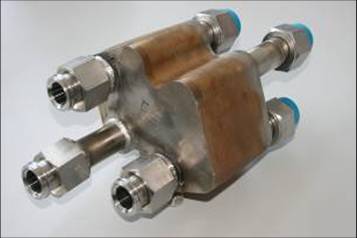The oxidation of sulfur dioxide to trioxide is just one step of the sulfuric acid production and is often needed in smaller quantities for sulfation or sulfonation. The equilibrium reaction is very fast and exothermic by -98 kJ / mol. To control the reaction in industrial scale and to take the equilibrium into account, which by temperature increase is falling, a staged reactor is commonly used. Between the stages cold gas could be injected or an external heat exchanger serves for inter-stage cooling. The feed gas consists of air with SO2 in low concentration and thus very large reactors are usually required and a higher effort of exhaust gas purification is necessary.
The use of a microstructure reactor for this reaction is therefore attractive in many ways. Under the assumption that the concentration of SO2 is increased, the reaction is performed with pure oxygen and a counter-current cooling gas flow could be used to reach complete conversion in one reactor. It would be possible to obtain a much smaller reactor size and to avoid purification of exhaust gas in case of a decentralized production.
In terms of the SO2 oxidation, the institute is developing appropriate concepts of temperature control in micro-reactors. By means of experiment and simulation we investigate various concepts such as countercurrent cooling (see "Water Gas Conversion”) or segmented temperature control and develop suitable catalysts.
 Pilot reactor with segmented cooling for production of 1kg/h SO3
Pilot reactor with segmented cooling for production of 1kg/h SO3